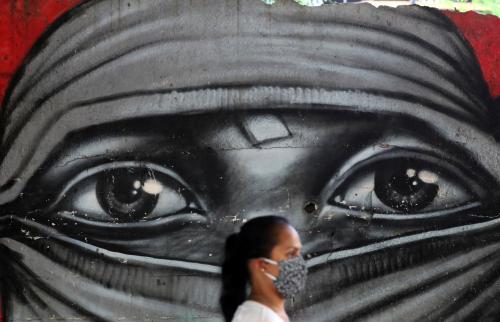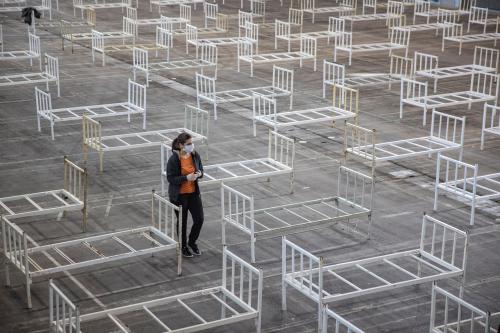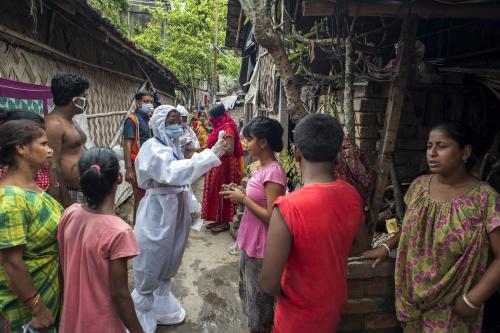Almost uniformly across the developing world, pandemic policy responses so far have tried to replicate the typical developed country strategy: social distancing coupled with national lockdowns, quarantining suspected cases in centralized locations, and increasing hospital capacity of hospitals by shoring up their intensive care units (ICUs) and increasing the supply of invasive mechanical ventilators. This will almost certainly have to change.
To be sure, the steps being taken by advanced countries are significant and they could prove to be adequate if the caseload remains between 10-20 per 100,000 and the associated mortality between 0.5-1.0 per 100,000. But to help poorer countries deal with infection rates in the neighborhood of the 30,000 per 100,000 being predicted by the modeling work of the Imperial College COVID-19 team—even with social distancing—these strategies will have to be supplemented by an entirely different set of measures. This is because there is a concern that—as the Italians discovered much later than they should have—with infection rates of about 300 per 100,000, even well-equipped hospital systems become overwhelmed. In such conditions, mechanical ventilation is not an effective strategy even for those individuals fortunate enough to get access to one, and hospitals themselves become lethal transmitters of infection back into the community.
Empower communities
Many low- and middle-income countries (LMICs) lack adequate hospital and emergency transportation infrastructure, but most have strong community-based structures, such as community-based organizations and local nonprofits. LMICs could benefit from the near ubiquitous presence of these nonprofit organizations if their governments empower them to, among other things:
- Identify the most vulnerable, such as individuals over the age of 60, and guide their families on how to protect them over the next several years until a good adult vaccine is developed;
- Communicate home care and isolation guidelines even for the very sick, including the development of collaborative arrangements between families where space within a single home is limited;
- Map the local primary care provider (PCP) network, including private and the nonprofit providers and, wherever possible, assign households to specific PCPs so that when the numbers start to rise, there is no confusion as to who is responsible for taking care of particular families;
- Ensure that these PCPs are well prepared to manage all but the sickest of the cases; and
- Provide essential support to those families that are in the greatest economic need.
Additionally, while PCP availability varies greatly across LMICs, given the high levels of out-of-pocket expenditures in most of them, the supply of independent formally qualified PCPs is likely to far exceed the numbers within government facilities, even in relatively remote areas.
Support primary care providers
After these PCPs have been identified, they have to be quickly trained and supported by carefully selected partners. Two services need to be emphasized: oxygen therapy and routine health care.
An analysis of 72,314 cases by the Chinese Center for Disease Control and Prevention suggests that the severity profile for COVID-19 patients will be in the shape of a pyramid in which, of the total number of patients, almost 80 percent could recover at home with mild to moderate illness. Of the remaining 20 percent, 75 percent could be treated for breathlessness and hypoxia using oxygen therapy in primary care settings. Of those receiving oxygen therapy, only 25 percent (i.e., 5 percent of the total) may need hospital-based intensive care or mechanical ventilation. Finally, of those receiving intensive care or mechanical ventilation, it is possible that only 20 percent (i.e., 1 percent of the total cases) may survive.
Unfortunately, as Baker et al point out, “the headline figures of ICU requirements for COVID-19 patients in resource-rich settings are masking the need for essential care. Attention is directed toward expensive, high-tech equipment that demands highly trained providers while neglecting low-cost essential care. To avoid this neglect … a primary policy focus on basic, effective actions with potential population impact [is recommended].” The need for facility readiness and good quality clinical practice for the dual aspects of identification and care of critically ill patients should be stressed. “The central role of oxygen therapy should be emphasized, oxygen supplies and delivery systems secured, and guidelines for sustainable and appropriate use issued.” Training and ongoing support for this can be provided to PCPs through a combination of training videos and tele-consultation by remotely located specialists.
Routine health care is as important as coronavirus-related care. Governments in developing countries will have to ensure that non-COVID-19 deaths do not start spiking while the attention of the entire health system is focused on COVID- 19, and to address concerns relating to comorbidities in the context of COVID-19. PCPs will need to be provided with structured guidelines on: (a) how to organize their clinics; (b) how to triage and stream patients; and (c) how to offer phone-based consultations to symptomatic or high-risk patients under their care. PCPs—not just their patients—will also need ready access to specialists who can provide them with detailed one-on-one phone or smart-phone based guidance and training on how to take care of unanticipated complications.
Play to your strengths
There is no doubt that, to the extent it is feasible to do so in an LMIC setting, hospital-based facilities will need to be improved to address the needs of the small proportion of patients who will truly benefit from mechanical ventilation. However, in order to build preparedness for a potentially large increase in the infection rate from the SARS-COV-2 virus, it will become important for LMICs to play to their strengths, and to rapidly build the capacity of their community-based organizations and primary care providers to respond to this crisis.
Some evidence that this can be done comes from India. Ambuja Cement Foundation and Basic Healthcare Services, both of which operate in remote rural parts of India, are showing that the approach has considerable promise. Additionally, it has the potential to serve the immediate COVID-19-related needs of low and middle income countries and leave behind a much stronger primary health care system, thereby providing a good example of the “Diagonal Approach” to health systems strengthening.







Commentary
In developing countries, communities and primary care providers—not hospitals—hold the key to successful pandemic response
May 14, 2020